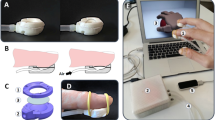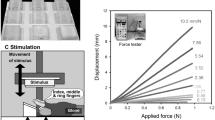Abstract
We proposed the “Tactile Clip,” a device to induce an illusion of softness, and verified its effectiveness in augmenting softness perception. A Tactile Clip is a wearable device that provides circumferential-force stimulation to the feet. This force results in the deformation of the foot skin, consequently influencing the perception of softness. We conducted a psychophysical experiment using the interleaved staircase method. Twelve participants assessed foot softness by comparing the stepping sensation of the reference sample with the Tactile Clip to that of the test samples without the Tactile Clip. From the response rate, we derived a psychometric curve and bias value. The results showed a significantly positive bias in the perception, suggesting that the Tactile Clip made the flooring material feel softer than the actual softness. We consider the factors contributing to this phenomenon as a slight increase in the foot’s thickness by deformation of sole skin and/or cognitive effects due to changes in force stimulation on the side of the foot in response to stepping.
Access this chapter
Tax calculation will be finalised at checkout
Purchases are for personal use only
Similar content being viewed by others
References
Giri, G.S., Maddahi, Y., Zareinia, K.: An application-based review of haptics technology. Robotics 10(1), 29 (2021)
Adilkhanov, A., Rubagotti, M., Kappassov, Z.: Haptic devices: wearability-based taxonomy and literature review. IEEE Access 10, 91923–91947 (2022)
Je, S., et al.: Elevate: a walkable pin-array for large shape-changing terrains. In: Proceedings of the 2021 CHI Conference on Human Factors in Computing Systems, pp. 1–11. Online Virtual Conference (originally Yokohama, Japan) (2021). https://doi.org/10.1145/3411764.3445454
Iwata, H., Yano, H., Fukushima, H., Noma, H.: Circulafloor [locomotion interface]. IEEE Comput. Graph. Appl. 25(1), 64–67 (2005)
Hollerbach, J. M., Xu, Y., Christensen, R. R., Jacobsen, S. C.: Designspecifications for the second generation sarcos treadport locomotion interface. In: ASME 2000 International Mechanical Engineering Congress and Exposition, vol. 69, no. 2, pp. 1293–1298. Orlando, Florida, USA (2000). https://doi.org/10.1115/IMECE2000-2446
Visell, Y., Giordano, B.L., Millet, G., Cooperstock, J.R.: Vibration influences haptic perception of surface compliance during walking. PLoS ONE 6(3), e17697 (2011)
Blom, K.J., Haringer, M., Beckhaus, S.: Floor-based audio-haptic virtual collision responses. In: Joint Virtual Reality Conference ICAT - EGVE - EuroVR, pp. 57–64. Madrid, Spain (2012). https://doi.org/10.2312/EGVE/JVRC12/057-064
Otaran, A., Farkhatdinov, I.: Haptic ankle platform for interactive walking in virtual reality. IEEE Trans. Vis. Comput. Graph. 28(12), 3974–3985 (2021)
Teng, S., Lin, C., Chiang, C., Kuo, T., Chan, L., Huang, D.: TilePop: tile-type pop-up prop for virtual reality. In: The 32nd Annual ACM Symposium on User Interface Software and Technology, pp. 639–649. New Orleans, LA, USA (2019). https://doi.org/10.1145/3332165.3347958
Chang, W., Je, S., Pahud, M., Sinclair, M.J., Bianchi, A.: Rendering perceived terrain stiffness in VR via preload variation against body-weight. IEEE Trans. Haptics 16(4), 616–621 (2023)
Strohmeier, P.R., Güngör, S., Herres, L., Gudea, D., Fruchard, B., Steimle,J.: bARefoot: Generating virtual materials using motion coupled vibration in shoes. In: The 33rd Annual ACM Symposium on User Interface Software and Technology, pp. 579–593. Virtual (previously Minneapolis, Minnesota, USA) (2020).https://doi.org/10.1145/3379337.3415828
Wang, Y., Truong, T.E., Chesebrough, S.W., Willemsen, P., Foreman, K.B., Merryweather, A.S., Hollerbach, J.M., Minor, M.: Augmenting virtual reality terrain display with smart shoe physical rendering: a pilot study. IEEE Trans. Haptics 14(1), 174–187 (2020)
Yang, T., Son, H., Byeon, S., Gil, H., Hwang, I., Jo, G., Choi, S., Kim, S., Kim, R.: Magnetorheological fluid haptic shoes for walking in VR. IEEE Trans. Haptics 14(1), 83–94 (2020)
Yokota, T., Ohtake, M., Nishimura, Y., Yui, T., Uchikura, R., Hashida, T.: Snow walking: motion-limiting device that reproduces the experience of walking in deep snow. In: 6th Augmented Human International Conference, pp. 45–48. Singapore, Singapore (2015).https://doi.org/10.1145/2735711.2735829
Tanaka, Y., Sano, A., Ito, M., Fujimoto, H.: A novel tactile device considering nail function for changing capability of tactile perception. In: 6th International Conference, EuroHaptics 2008. Lecture Notes in Computer Science, vol. 5024, pp. 543-548, Madrid, Spain (2008)
Tao, Y., Teng, S., Lopes, P.: Altering perceived softness of real rigid objects by restricting fingerpad deformation. In: The 34th Annual ACM Symposium on User Interface Software and Technology, pp. 985–996. Virtual (2021).https://doi.org/10.1145/3472749.3474800
Friedman, R.M., Hester, K.D., Green, B.G., Lamotte, R.H.: Magnitude estimation of softness. Exp. Brain Res. 191(2), 133–142 (2008)
Acknowledgments
This work was supported by JST Moonshot R&D Program “Cybernetic being” Project (Grant number JPMJMS2013) and Inamori Research Institute for Science. We gratefully acknowledge HOTTA CARPET CO.,LTD, JAPAN CRAFT&LOCALITY ASSOCIATION, and Mitsubishi Research Institute, Inc.
Author information
Authors and Affiliations
Corresponding author
Editor information
Editors and Affiliations
Rights and permissions
Copyright information
© 2025 The Author(s), under exclusive license to Springer Nature Switzerland AG
About this paper
Cite this paper
Yukawa, H. et al. (2025). Tactile Clip: A Wearable Device for Inducing Softness Illusion Through Skin Deformation. In: Kajimoto, H., et al. Haptics: Understanding Touch; Technology and Systems; Applications and Interaction. EuroHaptics 2024. Lecture Notes in Computer Science, vol 14768. Springer, Cham. https://doi.org/10.1007/978-3-031-70058-3_20
Download citation
DOI: https://doi.org/10.1007/978-3-031-70058-3_20
Published:
Publisher Name: Springer, Cham
Print ISBN: 978-3-031-70057-6
Online ISBN: 978-3-031-70058-3
eBook Packages: Computer ScienceComputer Science (R0)




